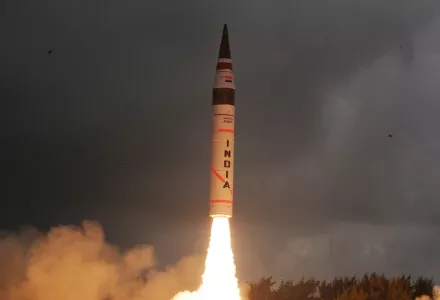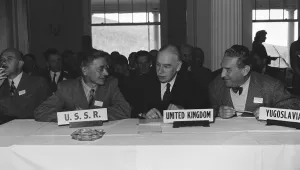International Security is America's leading peer-reviewed journal of security affairs.

This policy brief is based on “India’s Counterforce Temptations: Strategic Dilemmas, Doctrine, and Capabilities,” which appears in the winter 2018/19 issue of International Security.
Bottom Lines
Counterforce incentives. Pakistan’s threats of nuclear first use have given India incentives to develop disarming capabilities that might neutralize Pakistan’s nuclear capabilities in a future conflict. The goal of such a shift would be to allow New Delhi to recapture the space it believed it had lost for conventional retaliation, without fear of nuclear use from Pakistan and without having to engage in tit-for-tat nuclear warfighting.
Expanding options without doctrinal change. This risk of first-strike instability may force India to consider circumstances under which it could use nuclear weapons preemptively, posing a challenge to its long-standing “no first use” (NFU) declaration. Senior former officials have argued that preemption may be consistent with India’s NFU policy, meaning that Indian nuclear strategy may be changing even without any public revisions to its declaratory doctrine.
Growing but still insufficient capabilities. India has dramatically expanded the number of precise nuclear-armed and conventional weapons that it possesses that can strike deep into Pakistan, along with the necessary systems and infrastructure to find and destroy Pakistani nuclear systems and intercept any forces it may miss with missile defenses. Nevertheless, it is far from achieving the ability to execute counterforce strikes against Pakistani nuclear targets, but even the mere pursuit of such options creates both an arms race on the Indian subcontinent as well as dangerous incentives to strike first in a crisis.
India’s dissatisfaction with its current deterrence relationship with Pakistan was abundantly clear in February and March 2019. On February 26, India launched a series of standoff strikes using precision-guided munitions on an alleged terrorist training camp near the town of Balakot in Pakistan. The Indian government stated that the targeted facility served as a training camp for Jaish-e-Mohammad, a terrorist organization, which claimed responsibility for a February 14, 2019, suicide attack on Indian paramilitary forces in Kashmir that killed forty security personnel. The success of those strikes in destroying their intended target is still being debated. The following day, Pakistan retaliated with a standoff strike of its own, along with a substantial escalation of ground operations along the Line of Control in the disputed territory of Jammu and Kashmir. The crisis de-escalated following the capture by Pakistan of an Indian pilot and his subsequent release.
The February crisis represents the first ever use of airpower by a nuclear-armed state against the territory of another nuclear-armed state, and it showed how vulnerable the India-Pakistan relationship is to rapid escalation. Had the Indian pilot not been captured alive and expeditiously returned, it is uncertain whether the tit-for-tat escalatory spiral would have ceased after just one round of strikes. Prime Minister Narendra Modi himself declared that India was preparing to launch conventional missile strikes if the pilot remained in Pakistani custody. South Asia was a couple of wrong turns away from serious escalation, with corresponding steps up the nuclear alert ladder.
Approximately one month later, Prime Minister Modi announced that India had intercepted one of its own satellites with a kinetic kill vehicle. Modi emphasized, and international attention focused on, India’s demonstration of its anti-satellite capabilities. The test, however, used a modified version of India’s ballistic missile defense interceptor and also demonstrated the growing capabilities that India has to intercept high-altitude and high-velocity targets, such as those that would be associated with longer-range Pakistani missiles. The significance of the test for missile defense was not lost on Pakistan.
The events of early 2019 underscore the intersection of two longer-range trends: (1) India’s continued dissatisfaction with being unable to deter or halt Pakistani state sponsorship of anti-India terrorist groups; and (2) growing Indian military capabilities to find, fix, and kill Pakistani strategic assets. These trends have generated powerful temptations for Indian leaders to develop options that would permit counterforce targeting of Pakistan’s long-range nuclear systems in the event of a serious conflict.
Counterforce Incentives
Large states do not like to be deterred by smaller ones, but that is the position in which India has found itself since Pakistan acquired nuclear weapons in the mid-1980s. India alleges that Pakistan continues to support anti-India terrorist and militant groups that have killed tens of thousands of Indian civilians and security personnel over the last three decades. All the while, Pakistan has threatened to use nuclear weapons in the event of a major conventional conflict with India, which has constrained India’s ability to retaliate for fear of tripping Pakistan’s nuclear redlines.
As the 2019 Balakot episode underscores, Pakistan’s nuclear weapons and strategy do not prevent any and all Indian retaliation, but it does substantially cap how much—and what type of—force India can employ. Because countervalue Pakistani nuclear use against Indian cities in retaliation for Indian ground attacks might be perceived as disproportionate and incredible, Pakistan has emphasized since 2011 its ability and willingness to use nuclear weapons on the battlefield in an attempt to further restrict India’s space to conduct punitive military options, especially those that rely on India’s quantitatively superior armor and maneuver warfare forces. This strategic stalemate prompted a search for options that would enable India to reestablish deterrence of Pakistan’s sponsorship of militant and terror groups. The Balakot attacks were one product of that search, with India seeking to use discrete air strikes to limit escalation even as New Delhi signaled resolve. Pakistan’s counterattacks also show, however, that even airpower has the potential to result in escalation.
In the event of escalation, some Indian strategic thinkers appear to have concluded that India must have a credible ability to disarm Pakistan of its long-range nuclear systems in order to implement a strategy of escalation dominance, where India can threaten credibly to escalate and defeat Pakistan at every potential level of violence. These systems would also provide India a last-resort option in the event that Pakistan’s nuclear forces were to fall into the hands of extremists.
Expanding Options without Doctrinal Change
India issued its official nuclear doctrine in 2003 and has never revised it. The doctrine declares that “nuclear weapons will only be used in retaliation against a nuclear attack on Indian territory or on Indian forces anywhere.” That has not stopped a growing chorus of serving and retired senior officials in India from questioning the wisdom of an absolute NFU policy. To date, India’s then-defense minister, Manohar Parrikar (who served in the Modi government), former National Security Adviser Shivshankar Menon, former Chief of Navy Staff and Chairman of the Chiefs of Staff Committee Adm. Arun Prakash, and former Nuclear Strategic Forces Commander Lt. Gen. Balraj Nagal, among others, have publicly argued that India’s nuclear doctrine either currently permits or ought to permit nuclear first use, especially to preempt an imminent Pakistani nuclear strike. Menon, in particular, has suggested that preemption may be consistent with India’s existing doctrine, arguing, “India’s nuclear doctrine has far greater flexibility than it gets credit for.” All of these individuals occupied senior positions with responsibility for nuclear planning. Their statements of interest in preemption, particularly for counterforce options—the targeting option that can achieve serious damage limitation only if used preemptively—have emerged at the same time as India is increasingly capable to undertake such an ambitious effort.
Growing but Still Insufficient Capabilities
When India issued its nuclear doctrine in 2003, it had limited abilities to find Pakistani strategic assets using intelligence, surveillance, and reconnaissance capabilities and virtually no ability to locate those capabilities at night or through cloud cover. Currently, in addition to long-endurance unmanned aerial vehicles, India has access to an array of visual spectrum and synthetic aperture radar imagery from commercial satellites as well as its own government systems complemented by intelligence from friendly foreign governments.
Even if it could find Pakistani strategic assets, when India issued its nuclear doctrine in 2003, it had no operational ballistic missile systems with ranges greater than 250 kilometers; no meaningful standoff conventional capability from rockets, glide bombs, or cruise missiles; no ship-based or submarine-based operational cruise or ballistic missiles; and no unmanned aerial vehicles capable of long endurance. Now it can target much of Pakistan with a variety of land-based and sea-based ballistic and cruise missiles as well as target growing portions of Pakistan with air-launched weapons and missiles.
India has both focused on this suite of capabilities and has benefited from global technological changes that have led some scholars to suggest a new era of counterforce may be emerging. Even if a disarming strike did not entirely succeed, India has also invested in both indigenous ballistic missile defense capabilities and imported systems such as the Russian S-400. These capabilities would be wholly inadequate to stop a Pakistani first strike, but they might have some ability to intercept residual Pakistani weapons that remained after an Indian disarming attempt.
Nevertheless, India is unlikely to have the capability to disarm Pakistan in the near to medium term. Its mere interest in such a capability, however, is likely to stimulate a substantial Pakistani counter-response, accelerating a nascent South Asian arms race. Awareness of the possibility of a disarming strike might also engender greater Pakistani risk taking—including early consideration of a first strike by Islamabad—in the event of a serious future Indo-Pakistani conflict. Thus, New Delhi’s pursuit of counterforce options designed to help India escape its strategic paralysis are likely to trigger substantial strategic instability in South Asia. Indeed, one disturbing lesson from the Balakot retaliation and its aftermath is that Indian overconfidence in its capabilities may lead it to believe it can execute a counterforce strike in extreme circumstances, even if it cannot, which would place New Delhi, and the world, in an incredibly dangerous and destabilizing position.
Related Resources
Christopher Clary and Ankit Panda, “Safer at Sea? Pakistan’s Sea-Based Deterrent and Nuclear Weapons Security,” Washington Quarterly, Vol. 40, No. 3 (Fall 2017), pp. 149–168, doi.org/10.1080/0163660X.2017.1370344.
Keir A. Lieber and Daryl G. Press, “The New Era of Counterforce: Technological Change and the Future of Nuclear Deterrence,” International Security, Vol. 41, No. 4 (Spring 2017), pp. 9–49, doi.org/10.1162/ISEC_a_00273.
Austin Long and Brendan Rittenhouse Green, “Stalking the Secure Second Strike: Intelligence, Counterforce, and Nuclear Strategy,” Journal of Strategic Studies, Vol. 38, Nos. 1–2 (February 2015), p. 58, doi.org/10.1080/01402390.2014.958150.
Vipin Narang, Nuclear Strategy in the Modern Era: Regional Powers and International Conflict (Princeton, N.J.: Princeton University Press, 2014).
Christopher Clary is an assistant professor of political science at the University at Albany, State University of New York.
Vipin Narang is an associate professor of political science at the Massachusetts Institute of Technology and a member of MIT’s Security Studies Program.
International Security is America’s leading peer-reviewed journal of security affairs. It provides sophisticated analyses of contemporary, theoretical, and historical security issues.
International Security is edited at Harvard Kennedy School’s Belfer Center for Science and International Affairs and is published by The MIT Press.
For more information about this publication, please contact the International Security publications coordinator at 617-495-1914.
Statements and views expressed in this policy brief are solely those of the authors and do not imply endorsement by Harvard University, the Harvard Kennedy School, or the Belfer Center for Science and International Affairs.
Clary, Christopher and Vipin Narang. “India's New Nuclear Thinking: Counterforce, Crises, and Consequences.” May 24, 2019







